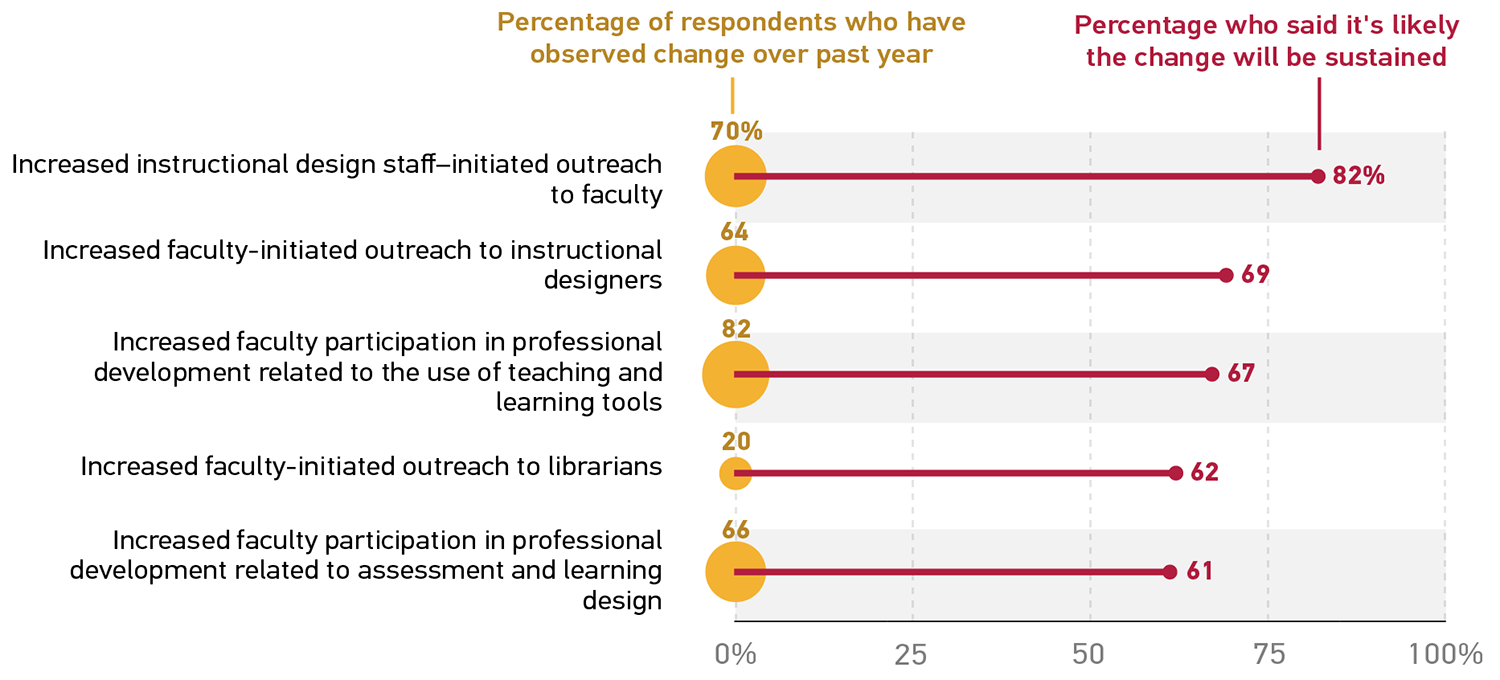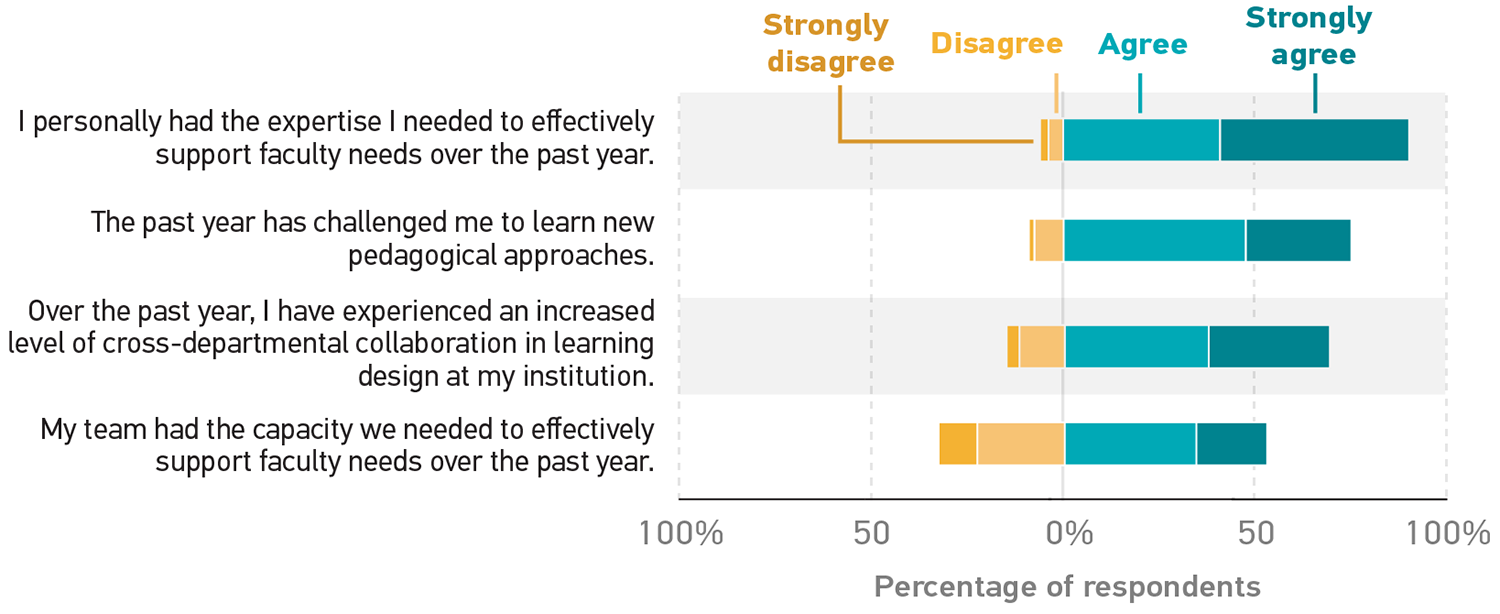Faculty engagement with instructional resources has increased and will likely persist in coming academic years. Whether larger institutional changes persist will rely on key investments and increased cross-departmental collaboration.

EDUCAUSE is helping institutional leaders, IT professionals, and other staff address their pressing challenges by sharing existing data and gathering new data from the higher education community. This report is based on an EDUCAUSE QuickPoll. QuickPolls enable us to rapidly gather, analyze, and share input from our community about specific emerging topics.Footnote1
EDUCAUSE would like to acknowledge and thank the American Institutes for Research for its collaboration on this week's QuickPoll survey and report. In particular, we are grateful to Kelle Parsons and Jessica Mason for their collaboration and thought partnership on this research, helping craft the survey questions, and reviewing this article.
The Challenge
Change has been the only constant in higher education over the past year. Faculty are adapting to new instructional tools for delivering their courses. Students are navigating new terrain in their hybrid and online learning environments. IT and instructional staff are being called upon to provide new and additional services and supports. And yet, though these changes are by now very familiar to us, we are far less certain of whether larger institutional structures and cultures are adapting to support these changes and whether these changes will take root and persist into a post-pandemic future. For this QuickPoll, we turn our attention to these uncertainties about the depth and persistence of new educational practices.Footnote2
The Bottom Line
Respondents expressed confidence that recent increases in faculty engagement with instructional design and technology will continue in future academic years, as will institutions' adoption of hybrid/online education. Respondents are less confident that larger changes in institutional policy and practice will persist, and they do not anticipate that institutions will be investing in key instructional needs in the future. Increases in cross-department collaboration hold great promise for leaders seeking to engage faculty and make wider and more lasting strategic changes. Long-term success for new approaches to teaching and learning may rely at least in part on clear and consistent policies and practices across the institution, as well as a shift in institutional narrative from "short-term crisis mitigation" to "innovation for the future."
The Data: Are We Changing for Good, or Just for Now?
Faculty and staff are making long-term changes. The majority of respondents have observed important positive changes in faculty practice at their institutions, including increased faculty participation in critical areas of professional development and increased outreach between faculty and instructional design staff (see figure 1). Respondents also expressed a high level of optimism that these changes will be sustained in future years.

Institutional change may be less likely to persist. The majority of respondents have also observed important positive changes in institutional policies and practices regarding student preferences and academic structures (see figure 2). Compared with the observed changes in faculty practice, however, respondents appear less optimistic that these institutional changes will endure.

The Data: Changes Still Ahead
Hybrid/online learning may be here to stay. Strong majorities of respondents anticipate that their institution will increase or continue their offering of hybrid/online courses in a post-pandemic future and that faculty will continue to express an interest in those forms of education as well (see figure 3).

But we may lack critical investments in the future. Few respondents, however, anticipate that they will see expanded resources for supporting faculty development in teaching in learning, expanded staffing for instructional design, or a centralization or restructuring of instructional design and resources. This appears to reflect the earlier observation that institutional changes seem less likely to persist and would therefore be less likely to be areas of longer-term investment of institutional resources. It also seems at odds with the suggestion that hybrid/online education will somehow persist into the future, as these new modes of education apparently will be persisting without the needed staffing and resources to support them.
The Data: How Far Have We Come?
Collaboration is key. This past year has been characterized by positive growth and learning in instructional practice. Strong majorities of respondents agreed that they had the expertise they needed to effectively support faculty and that they've been challenged to learn new pedagogical approaches (see figure 4). More than two-thirds of respondents have also experienced increased cross-departmental collaboration, an experience significantly associated with observed increases in faculty participation in professional development, changes in policies related to student assessment, and increased acknowledgment within the institution of student needs and preferences. This supports what we might suspect intuitively—that collaborative structures and processes foster increased buy-in and strategic alignment across units.

Capacity and staffing remain a challenge. Respondents generally expressed less agreement that their team had the capacity they needed to effectively support faculty over the past year. This finding squares with the skepticism that institutions will make important long-term changes, including investing in additional instructional design staff. It also squares with previous QuickPoll findings highlighting the stresses and strains institutional staff have been under as they are asked to take on more work and meet new demands without the help of adequate budgets or staff.
Common Challenges
Can faculty trust their students? New hybrid/online modes of teaching and assessment have uncovered faculty fears of student dishonesty and cheating. At worst, some faculty may be excessively rigid in their approaches to student participation, obsessively determined to "catch" devious behavior, and may be contributing to unhealthy learning environments.
- "I was surprised at the distrust the faculty have for the students. In many cases they believe cheating is happening constantly. I had one professor say they need to find a way to keep online students from being able to communicate with each other at all, not apparently considering that students in live classes communicate as well."
Some habits are hard to break. Though many faculty are embracing the opportunity to learn new skills and adopt new tools, some habits die hard. Faculty will continue to be challenged to rethink ingrained practices more suited to traditional face-to-face courses (e.g., multiple-choice exams) if investments in hybrid/online education are to be successful.
- "I was surprised by how unwilling some faculty were to even consider changing multiple-choice testing. Our teaching and learning center offered workshops and individual support, but some people refused to do anything else."
Literacies may be worse than we thought. Many faculty (and students) simply aren't the computer whizzes we might have expected and might even fall below the minimum threshold of technology or digital literacy required for meaningful engagement with new learning tools and environments. This may place additional strain on teams supporting faculty who are less capable than anticipated and therefore more demanding of their time and effort.
- "While I was aware that some faculty have poor technology skills, particularly those associated with using the LMS, the reality was worse than I had realized."
Infrastructure and resources are still inadequate. The digital divide persists as faculty and students still lack access to the connections and devices they need. And IT and instructional teams still lack the resources they need to do their work sustainably. Long-term success hinges on whether institutions invest in places where resources are needed.
- "Despite three semesters, each with its own iteration of remote and HyFlex, we were told ITS staff positions would not be added. We are all exhausted and trying to help everyone get through the semester and deal with pressure to get back to business as usual. There isn't capacity."
Promising Practices
Faculty education and exposure make a difference. Even those faculty seemingly most resistant to change can wind up singing a different tune if given the opportunity to learn about or experience first-hand a new tool or practice. Whether through incentives or mandates, creating those opportunities for faculty can go a long way to generating buy-in.
- "When late-adopter faculty apply research-based online teaching techniques, they are genuinely amazed. These concepts have been readily available, and due to the pandemic they finally realize the importance of online best practices."
Students still need empathy and support. Pandemic fatigue may be setting in, but recommitting ourselves to sharing extra measures of patience and understanding with our students and one another will help create learning environments built on respect and trust rather than suspicion and antagonism.
- "I have been surprised by how much faculty have rallied to support their students. I knew they would, but the extent that they have has been inspiring. They have looked for alternative ways to present course material, assess students informally, and engage with students to meet needs at varying levels."
Institutional leadership matters and can unite divided campuses. Not all faculty are alike, and openness to adopting new learning tools and models may vary across departments. Clear and consistent support for change from the institution's leadership can help ensure consistent practices across departments and help avoid splintered approaches to education within the same institution.
- "Departmental culture strongly influences faculty willingness to adapt. Departments and programs with strong faculty governance are more likely to have faculty make decisions based on personal impact rather than change instructional approaches or willingly adopt flexible models for teaching and learning."
We're not reacting to a crisis—we're innovating for the future. If leadership and faculty view changes as temporary solutions to a short-term crisis, they'll be more likely to revert back to old models and practices post-pandemic. But if they view them instead as opportunities to innovate and improve for the future, they may be more open to longer-term adoption. Building enthusiasm for the latter narrative should be a strategic focus now for IT and instructional leadership.
- "The desire to 'go back to normal' risks forgetting some of the lessons we have learned. Can we both 'go back to normal' and also retain what we have learned?"
All QuickPoll results can be found on the EDUCAUSE QuickPolls web page. For more information and analysis about higher education IT research and data, please visit the EDUCAUSE Review EDUCAUSE Research Notes topic channel, as well as the EDUCAUSE Research web page.
Notes
- QuickPolls are less formal than EDUCAUSE survey research. They gather data in a single day instead of over several weeks, are distributed by EDUCAUSE staff to relevant EDUCAUSE Community Groups rather than via our enterprise survey infrastructure, and do not enable us to associate responses with specific institutions. Jump back to footnote 1 in the text.
- The poll was conducted on March 30, 2021, consisted of 11 questions, and resulted in 433 responses. Poll invitations were sent to participants in EDUCAUSE community groups focused on IT leadership and teaching and learning. Our sample represents a range of institution types and FTE sizes, and most respondents (93%) represented US institutions. Jump back to footnote 2 in the text.
Mark McCormack is Senior Director of Analytics & Research at EDUCAUSE.
© 2021 Mark McCormack. The text of this work is licensed under a Creative Commons BY-NC-ND 4.0 International License.
